Overview
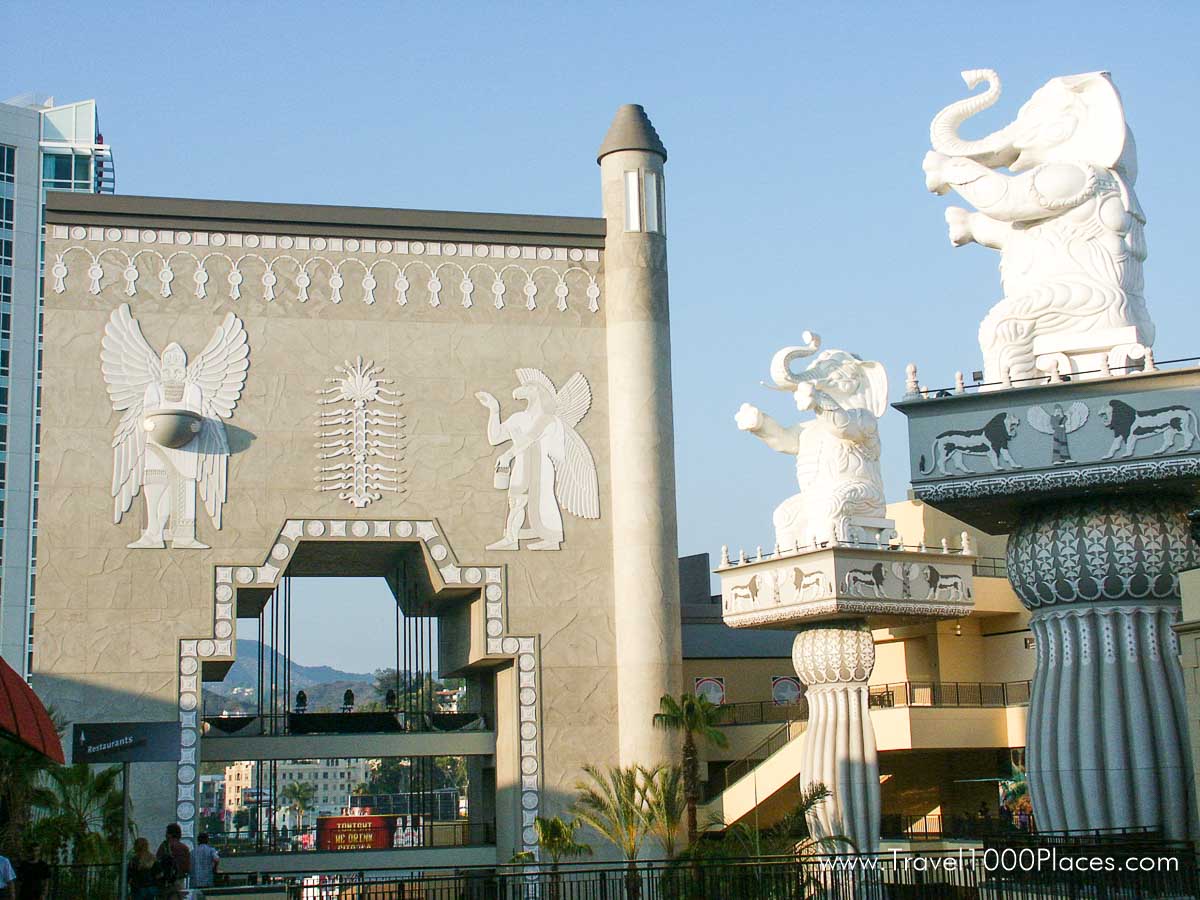
Downtown
- Olvera Street
- El Pueblo de Los Angeles Historic Monument
- Grand Central Market
- Angel’s Flight Railway
- California Plaza
- MOCA – Museum of Contemporary Art
- Ennis Brown House
- L.A. Public Library
- L.A. Music Center
- L.A. City Hall
- Grand Park
- Staples Center
- Little Tokyo & Chinatown
- Pershing Square
- Miracle Mile
- Los Angeles Center Studios
- Los Angeles Times Building
Hollywood
- Hollywood
- Walk of Fame
- Grauman’s Chinese Theatre
- Entertainment Museum
- Wax Museum
- Hollywood History Museum
- Dolby Theatre (former: Kodak Theatre), Hollywood & Highland
- GRAMMY Museum
- Hollywood Sign
- Hollywood Bowl
- Universal Studios
- Paramount Studios
- Warner Bros. Studios
- (in Burbank)
- Sony Pictures (former MGM Studios)
- Griffith Park
- Griffith Park Observatory
Read more:
Hollywood, Los Angeles, California
Near Los Angeles: Discover Southern California — Santa Monica, Venice, Hermosa Beach, Huntington Beach & more
Westside
- Westside
- Farmers Market
- Getty Center
- Museum Row on Wilshire’s Miracle Mile
- LA County Museum of Art: LACMA
Read more: Westside Los Angeles
West Hollywood
- Sunset Strip
- Legendary Clubs on Sunset Strip
- Sunset Strip Club: The Whiskey
- Sunset Strip Club: Viper Room & Roxy
Read more: West Hollywood L.A., California
Legendary Clubs on Sunset Strip: Whisky A Go Go, Viper Room, Roxy
Beverly Hills
- Beverly Hills
- Rodeo Drive, Wilshire Blvd & Co.
Read more: Beverly Hills, Los Angeles
San Fernando Valley
- Ronald Reagan Presidential Library and Museum
Los Angeles Harbor: Port of Los Angeles
- A Profile of the Port of Los Angeles
- Cruise Terminals
- History of the Port of Los Angeles
- A Timeline of Landmarks and Milestones
- Ports O’ Call (the maritime fishing village)
- USS IOWA at Port of L.A. Berth 87
Read more: Port of Los Angeles
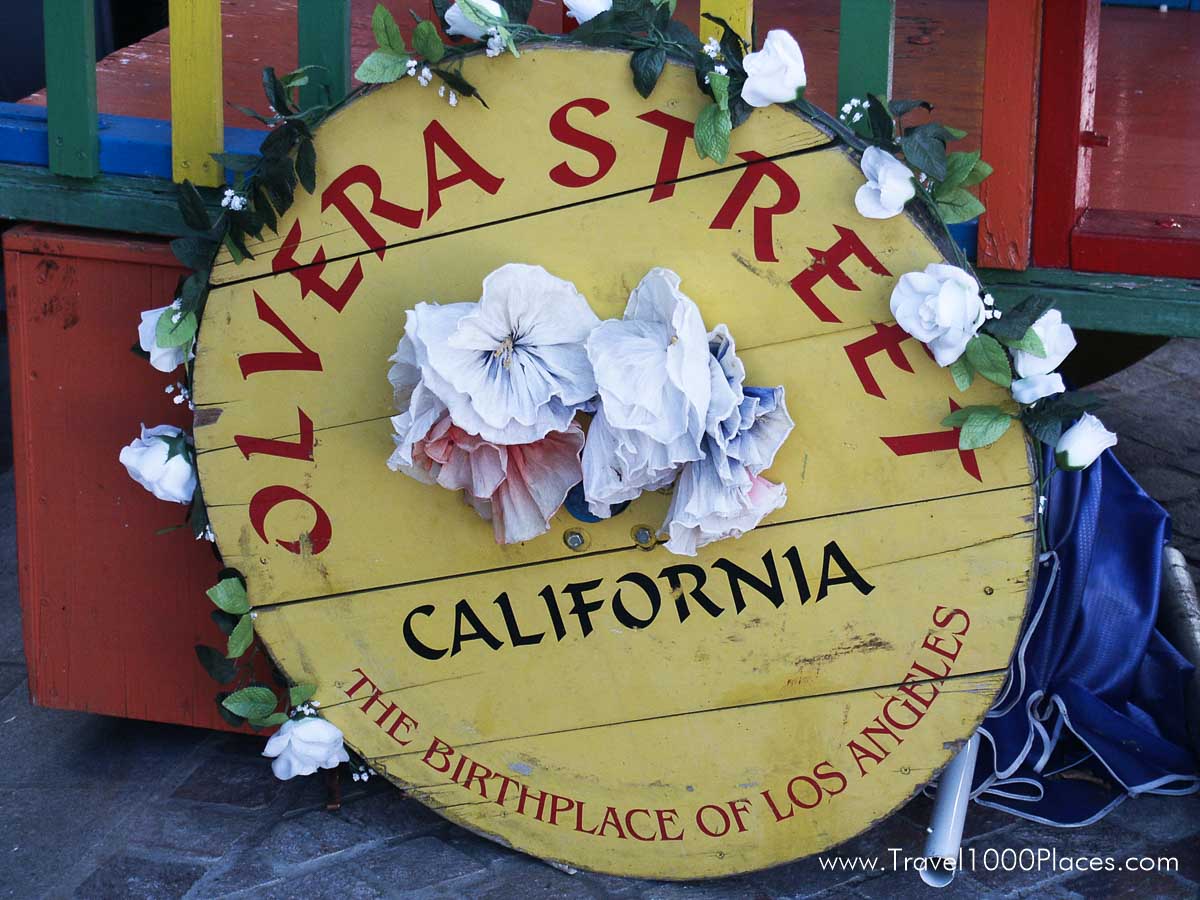
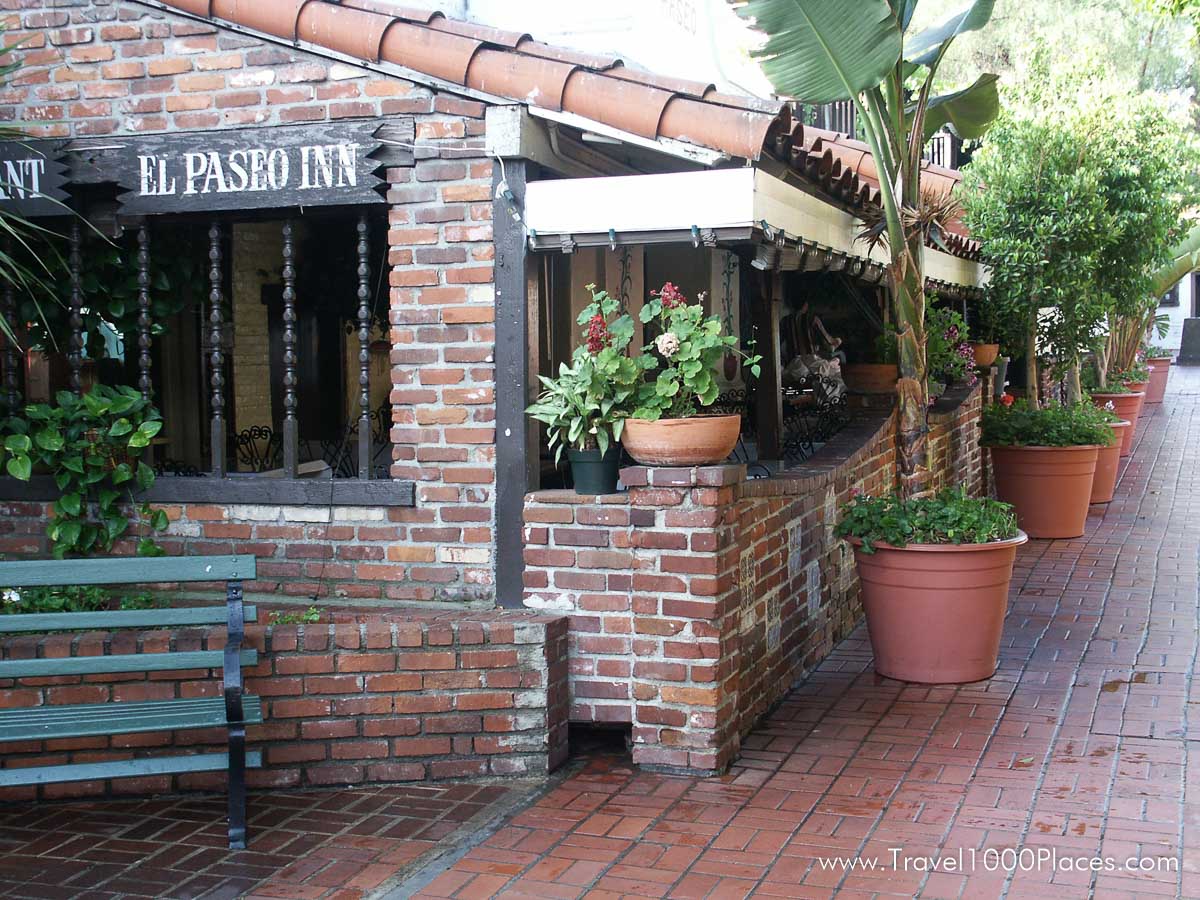
Downtown
Olvera Street
Brick paved, automobile free, crowded with shops, stalls, food stands and restaurants, Olvera Street is the centerpiece of the El Pueblo de Los Angeles Historic Monument, the founding site of the city.
It was in 1930 that the street was rebuilt as a marketplace and named for an L.A. County judge and supervisor. Over the years it has become a point of pride for the citizens of Los Angeles and the lifeblood of the city’s historic core.
El Pueblo de Los Angeles Historic Monument
El Pueblo is 44 acres bounded by Alameda, Arcadia, Spring and Macy Streets This is the founding site of the City of Los Angeles. It includes Olvera Street, a Mexican marketplace with shops and restaurants Avila Adobe, the oldest house in Los Angeles (1818), Masonic Hall built in 1858.
Old Plaza was the center of activities in the old pueblo of Los Angeles and contains a kiosk, century old Moreton Bay fig trees, and statues of Felipe de Neve (leader of the group that founded of the city in 1781) and King Carlos II, ruler of Spain. Old Plaza Church (Nuestra Senora la Reina de Los Angeles) is the oldest church in the city which was completed in 1822 by the Franciscans.
Old Plaza Firehouse built in 1884 houses an original chemical wagon, antique firefighting equipment and historic photographs Pico House once an elegant hotel built in 1870 by Pio Pico, the last governor of California under the Mexican flag Sepulveda House a two-story Eastlake Victorian building constructed in 1887.
It was once a boarding house with shops and currently houses the visitor center. During April/May, 1995 Archeological Consulting Services (ACS) have unearthed items from the native American period and treasures from the Spanish occupation of the area (1781 to 1820), the Mexican era (1820 to 1850) and the American period which dates from California’s 1850 entrance to the Union. They have uncovered tools, ceramics, bones, bottles, beads and other items from a pit located behind a store at the northwest corner of Olvera Street, the oldest thoroughfare in the City.
Downtown: Grand Central Market
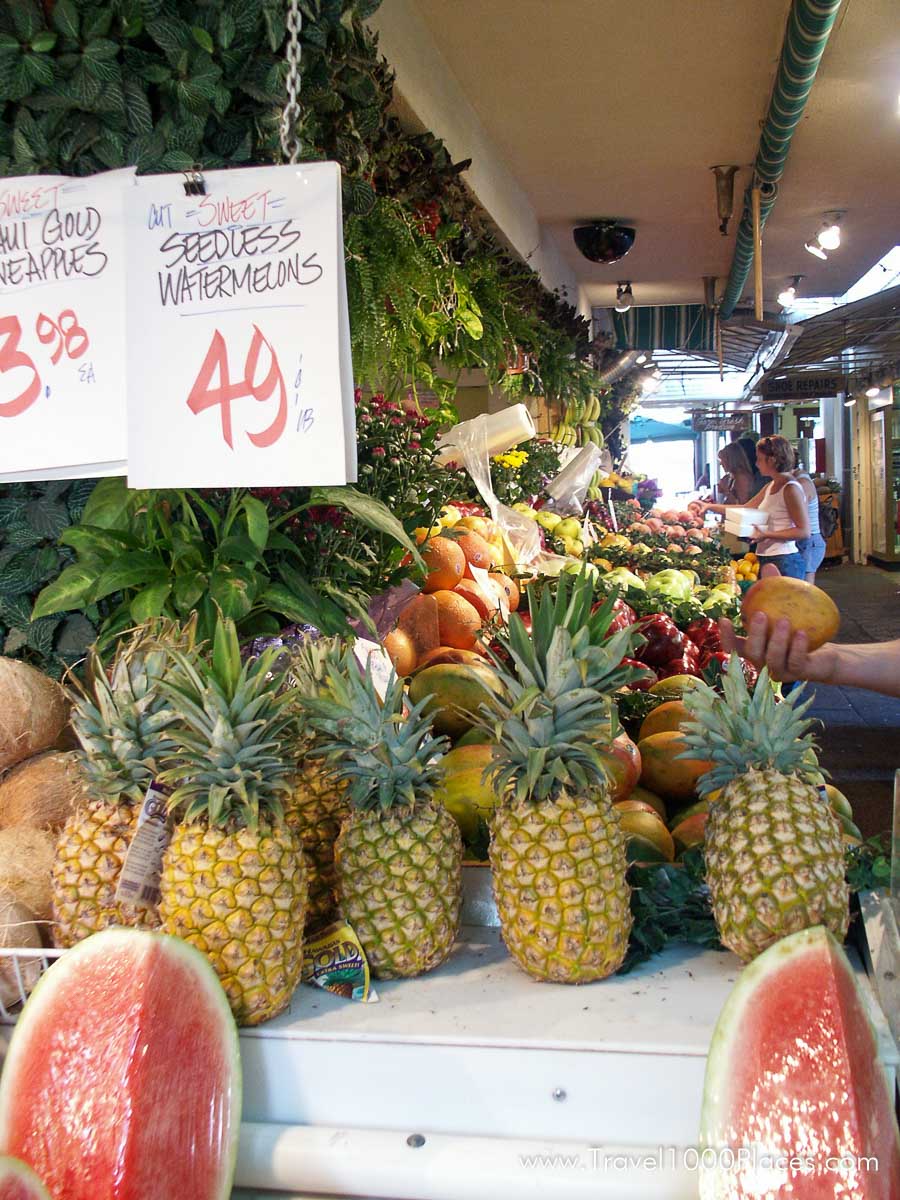
Experience the international diversity of Los Angeles at the Grand Central Market. Offering fresh fruits, vegetables, meats, poultry and fresh fish from California and around the world, the Grand Central Market has been a hub of bustling activity since 1917.
A place where thousands of people from all walks of life come to meet with old and new friends, shop for the best bargains in town or just to have a cone of ice cream on a sunny California afternoon.
Grand Central Market is located in the heart of downtown Los Angeles’ Historic District and is within walking distance of the financial district, government offices and courthouses, and major attractions such as Angels Flight, MOCA and the Music Center.
Downtown: Angel’s Flight Railway
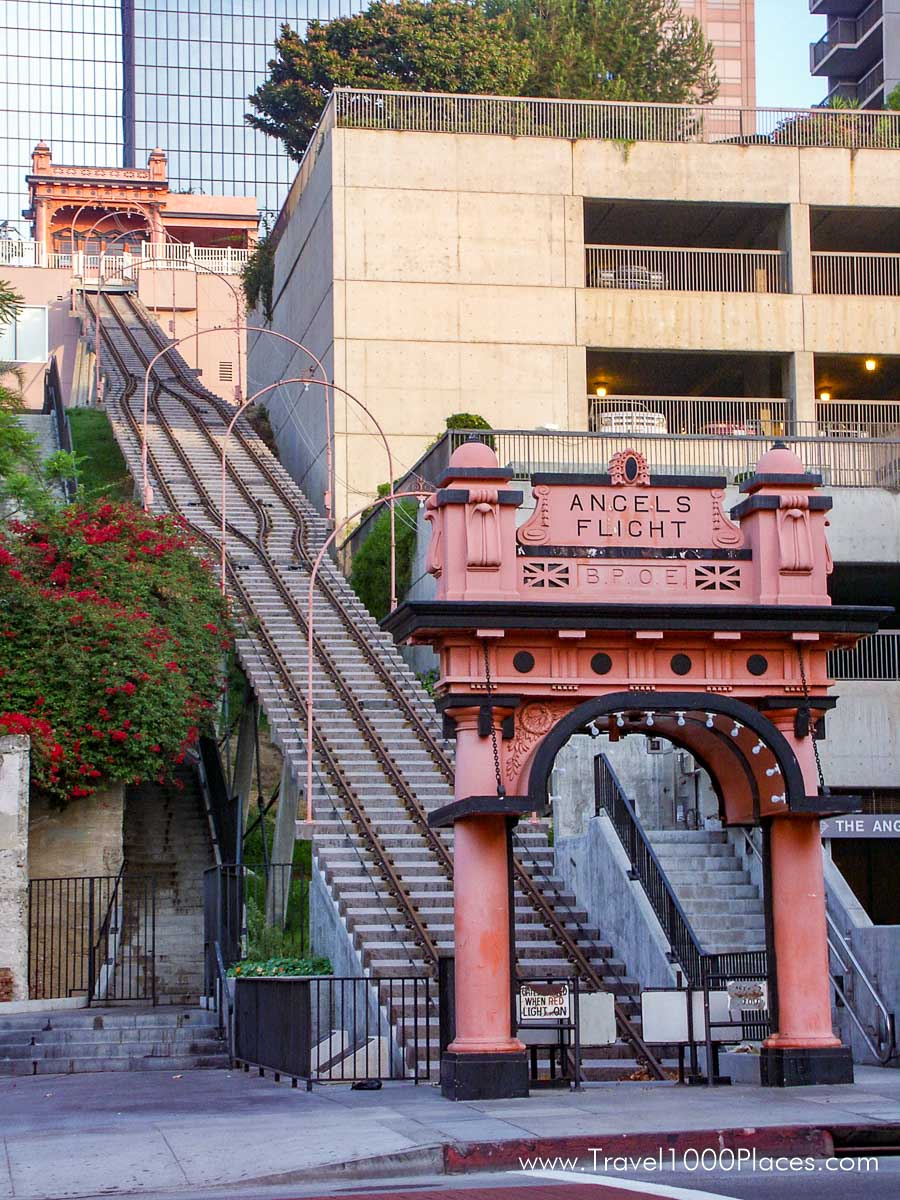
The shortest railway in the world connects the Fourth, Hill Street and Pershing Square Metro Red Line stations to the Watercourt at California Plaza.
Angels Flight™ Railway becomes Angels Walk between Hill Street and California Plaza, offering a pleasant trip with captivating views while riding in counterbalanced cars named ‘Olivet’ and Sinai up and down Bunker Hill. The shortest railway in the world connects the Fourth, Hill Street and Pershing Square Metro Red Line stations to the Watercourt at California Plaza The shortest railway in the world,” the Angels Flight funicular originally opened on December 31, 1901, to carry passengers for a penny a ride between what was then a fashionable residential neighborhood atop Bunker Hill and the offices and shopping emporiums below. The one-way fare rose to a nickel in 1914 and continued at that rate until the railway was dismantled and put into storage in 1969 as Bunker Hill was making its metamorphosis into a modern commercial center.
It started again after many stops and starts and the intervention of a variety of “angels,” most notably the Community Redevelopment Agency with the help of the Los Angeles County Metropolitan Transportation Authority, the promised restoration of the funicular was completed in 1996. Since then, it has been under the ownership of the non-profit Angels Flight™ Railway Foundation, and a one-way trip is now only 25 cents. All aboard!
Downtown: Miracle Mile
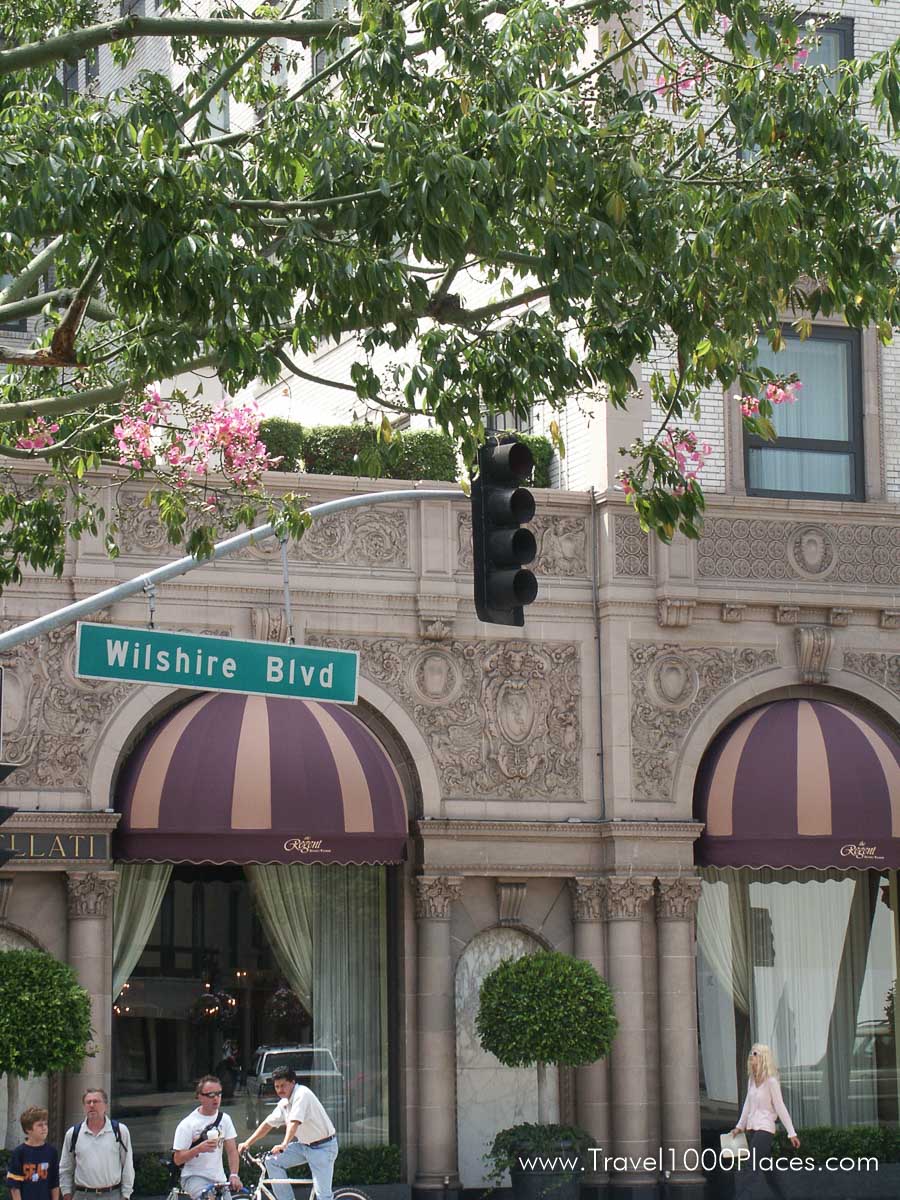
Wilshire is home to some of the city’s best department and specialty stores and handsome older buildings, slick glass highrises, lofty palm trees and lively pedestrian traffic. Stores include Neiman-Marcus, Jaeger, Saks Fifth Avenue and Buccellati. Miracle Mile, that’s between La Brea and Fairfax Avenue on Wilshire Boulevard.
This was named the ‘Miracle Mile” because A.W. Ross turned 18 acres of empty land along Wilshire Boulevard into a prestigious business and shopping district. Mr Ross actually supervised the designs of the buildings along the street.
Some of the buildings to look for are:
The Security Pacific Bank Building, (1929), 5209 Wilshire Boulevard,a black and gold miniature of the Richfield Tower
das Meyer & Holter Commercial Building, (1930), 5217-5231 Wilshire Boulevard, has an imposing set-back tower.
The Dark Room, (1927), 5370 Wilshire Boulevard, is a period camera in black vitrolite
das Frank M. Tyler’s Commercial Building, 5464 Wilshire Boulevard, has twin turrets that look like towering Japanese origami
das Dominguez-Wilshire Building, (1930), 5410 Wilshire Boulevard, includes a finely detailed tower which rises above a two-story base
Location:
Wilshire Boulevard – Miracle Mile is located between Roxbury und Crescent Drives
Downtown: One California Plaza
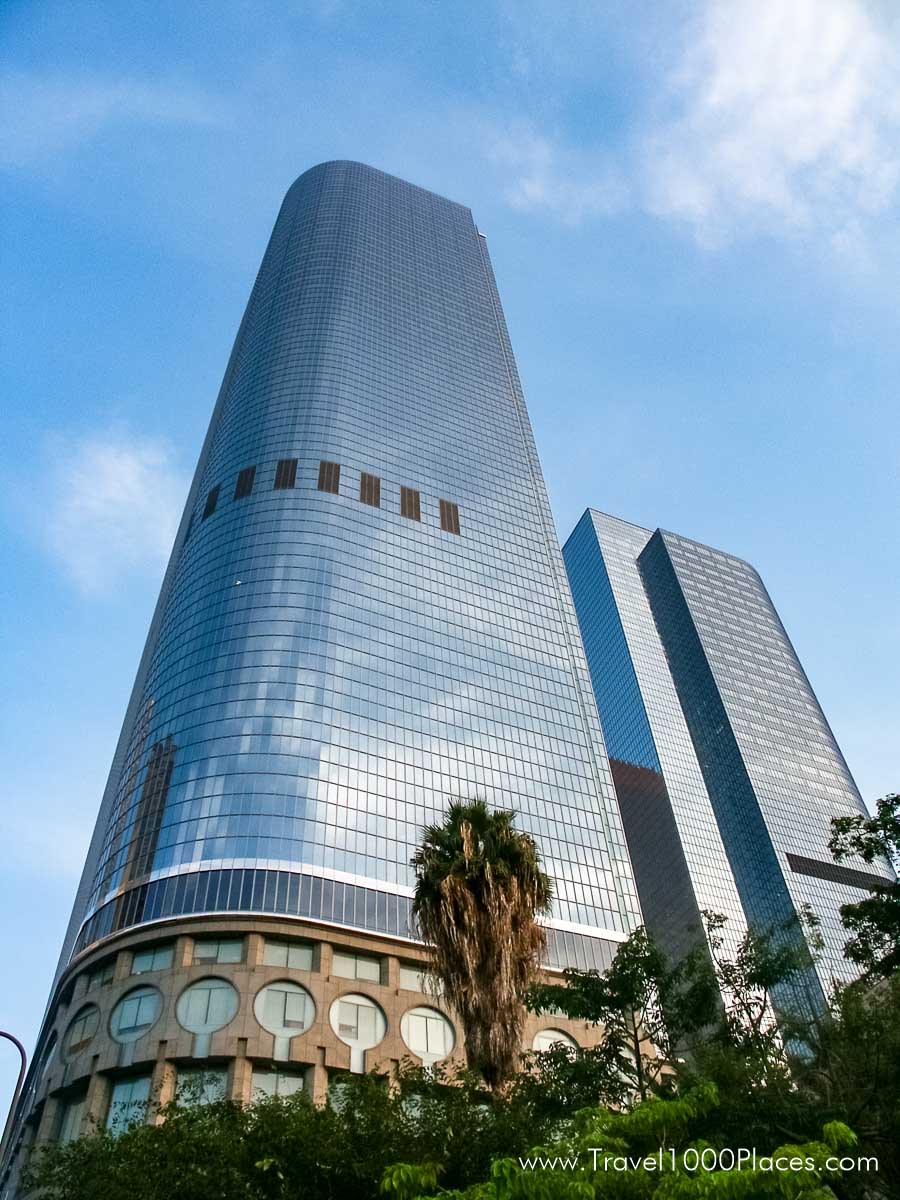
One California Plaza has a commanding presence in the downtown Los Angeles skyline. Situated atop Bunker Hill, California Plaza is comprised of two office buildings, numerous retail amenities, the Omni Hotel, Museum of Contemporary Art (MOCA), Colburn School of Performing Arts, Museum Tower residential apartments and the Water and Spiral Courts public performance venues.
California Plaza is connected to Hill Street to the east via the historic Angel’s Flight cable car.
One California Plaza is surrounded by downtown’s most important governmental, judicial, entertainment and residential sectors. Tenants have convenient access to a choice of three world-class hotels, over 30 restaurants, a dozen residential towers, and Los Angeles’ premiere cultural venues.
Downtown: MOCA
Permanent collection, thematic exhibitions of international scope. Painting, sculpture and environmental works created since 1940. MOCA’s galleries are clad in a distinctive rough-cut red Indian sandstone and topped by pyramidal skylights. The galleries themselves are entered down a flight of stairs leading to a courtyard from where you can view the sensuous curve of the parapet above, which architect Arata Isozaki says was inspired by the dimensions of Marilyn Monroe. Isozaki calls it the Monroe Curve.
MOCA at the Geffen Contemporary
152 North Central Avenue,
Los Angeles, CA 90013
Five minutes from Cal Plaza, and easily accessible by free shuttle, this former police-car garage houses some of MOCA’s largest exhibitions, and includes a branch of The MOCA Store.
MOCA at the Pacific Design Center
8687 Melrose Avenue, West Hollywood, CA 90069
Opened in January 2001, MOCA’s West Hollywood venue is the compact building next to the landmark Pacific Design Center, also known as the “Blue Whale.”
MOCA at California Plaza
250 S. Grand Ave.
Los Angeles
Downtown: EnnisBrown House
Ennis Brown Haus is the magnificent creation of world- famous architect Frank Lloyd Wright. It is one of the most outstanding residential structures existing in the United States. The Ennis-Brown House is one of the first residences constructed from concrete blocks.
Wright transforms cold industrial concrete to a warm decorative material used as a frame for interior features like windows and fireplaces as well as columns. His sixteen inch modular blocks with intriguing geometric repeats invite tactile exploration.
This beautiful example of the genius of Wright is visited by architects, architectural historians, artists and art lovers from practically every country in the world. he house is listed by the U.S. Department of the Interior in the National Register of Historic Places, it has been declared a Cultural Heritage Monument by the city of Los Angeles, and it has been designated a California State Landmark.
Downtown: L.A. Public Library
One of the city’s most treasures landmarks is the Los Angeles Public Library’s Central Library opened in 1926 and was built in a a style that mixed Byzantine, modern & Spanish themes. Enjoy the art and architecture of the wonderful Bertram Grosvenor Goodhue Building with its distinctive sphinxes and rooftop pyramid.
Wander through the high-tech. Bradley Wing, designed by famed architect Norman Pfeiffer, and gaze at the 8-story atrium with its whimsical chandeliers. Be sure to visit the Lodwrick M. cook Rotunda. Learn about the library’s comprehensive book, magazine, audio and videotape collections as well as its extensive network of informational databases.
Free docent tours are given daily.
Downtown: L.A. Music Center
The Music Center, which opened in 1964, reaches more than 2.6 million people each year and is home to the Los Angeles Philharmonic, the Center Theatre Group (the Mark Taper and the Ahmanson Theatre), the Los Angeles Opera and the Los Angeles Master Chorale as well as special events such as the recent performances of the Bolshoi Ballet and Army Field Band and Soldier’s Chorus.
The downtown Los Angeles complex includes the
Dorothy Chandler Pavilion, Mark Taper Forum, Ahmanson Theatre and Walt Disney Concert Hall.
Downtown: L.A. City Hall
The Los Angeles City Hall is still the most universally recognized city icon. The famous 450-foot tower reigned as the tallest building until the height restriction was lifted by the City Council in 1957.
Stylistically, City Hall is an artful blend of the Classical and Mediterranean traditions, with a decidedly Moderne spirit. On the interior, a Romanesque influence is predominant. The lower portion of the building is California light gray granite, while the upper portion and tower are covered with glistening terra cotta.
A popular spot for officai Speeching can be found behind the south steps of City Hall: The Frank Putnam flint Fountain.
Address:
200 North Main Street, Los Angeles
Grand Park spans four distinct blocks in the heart of downtown Los Angeles from The Music Center to City Hall. It’s divided into 4 blocks: Blocks One and Two (from Grand Avenue to Hill Street), Blocks Three and Four (from Hill Street to Spring Street).
Grand Park
Arthur J. Will Memorial Fountain – An historic yet previously hidden icon in Los Angeles, the 1960s-era Arthur J. Will Memorial Fountain is newly renovated and now the focal point of Grand Park. The fountain was restored and reenergized to create an interactive gathering place with different programs that produce various water shows with synchronized colored lights. The fountain’s new crowd-pleasing features include a 50-foot spray at the central bowl and the addition of a quarter-inch deep splash pad with circular patterns of interactive jets that encourage water play. Park visitors also can enjoy the fountain’s light show in the evening from the surrounding overlook or while passing through to the Metro Civic Center station, a parking lot or an alternate destination outside the park.
Olive Court – Olive Court includes 16 olive trees as well as the original historic benches and speaker poles, which have been restored to their original condition. This area is designed to serve as a gathering place for events such as art or book fairs, plant sales and small community events that might be held in conjunction with performances at the adjacent Performance Lawn.
Performance Lawn/Stage – Located towards Hill Street and just east of Olive Court, the Performance Lawn and stage are designed to accommodate smaller musical performances, art shows and other cultural events.
Landscape – The park was designed as a diverse collection of plantings from around the globe. With nearly 140 different species of plants, the park’s landscape intertwines native plantings and drought-tolerant species organized together into 24 gardens representing six Floristic Kingdoms. Many existing trees were preserved and now are complemented by the addition of more than 300 new trees planted throughout Grand Park.
Signature Colors – The park’s signature colors of magenta and green provide a counterpoint to the neutral colors of the surrounding buildings. The magenta corresponds to the foliage throughout the gardens and acts as a consistent “bloom” throughout the year. The new park buildings are predominantly green, allowing them to blend in with the foliage.
Park History
Grand Park represents a unique piece of civic real estate. Originally named El Paseo de Los Pobladores de Los Angeles (The Walk of the First Settlers of Los Angeles), and commonly known as the Civic Center Mall, Grand Park transformed and reinvigorated underused public space that was challenged by grade changes and underground garage access ramps. The Grand Avenue Committee—a public-private partnership formed in 2000, with James A. Thomas of Related Companies as the founding chairman and Eli Broad as co-chairman —included the concept for the park, an idea that had been entertained in civic circles since the 1950s, but which was most recently advanced by the Civic Center Authority chaired by Los Angeles County Supervisor Gloria Molina and Los Angeles City Councilmember Rita Walters. With the park as the Grand Avenue project centerpiece, Supervisor Molina agreed to form the Grand Avenue Authority in 2003 as a Joint Powers Authority between the County of Los Angeles and the Los Angeles Community Redevelopment Agency. Since then, the Grand Avenue Authority has overseen Grand Park design and development, as well as implementation of the larger Grand Avenue development plan. Construction on Grand Park began in July 2010 and was managed by the County of Los Angeles. The $56 million for the construction of Grand Park was comprised of $50 million in pre-paid rent for ground leases from Related Companies —a key condition Supervisor Molina was instrumental in securing—plus other city funds and interest.
Park Design
Los Angeles-based Rios Clementi Hale Studios designed the park after a multi-year planning process centered on civic engagement and feedback, a commitment that defines the form, function and spirit of Grand Park. The jumping off point for the design was the concept of Los Angeles as a dynamic cultural and global crossroads. Graphic inspiration came from a flattened map of the globe from the 1920s by J.P. Goode, an American cartographer. Together, these inspirations gave rise to an overlay of meridian paths and connections, ranging from an eight-foot wide walkway to an 18-inch footpath that crisscross the four blocks of the park.
With many of the existing trees preserved, the design was enhanced with the addition of masses of flowering trees and landscape plantings of species native to Southern California. The park also features trees, shrubs and flowers that reflect the heritages of the many who have made Los Angeles their home. The park’s floristic gardens, featuring many drought-tolerant species, were inspired by the world’s six Floristic Kingdoms—Boreal, Neotropical, Paleotropical, South African, Australian and Antarctic.
The Music Center, in conjunction with the county, oversees and operates Grand Park and plans to create a dynamic, inclusive environment for community events, cultural experiences, festivals, holiday celebrations and the like that engage and attract visitors from all communities in Los Angeles County. Park visitors will enjoy original programming, outdoor activities, interactive events, entertainment and many other activities that can benefit from the park’s multi-use lawns, stages and spaces. Grand Park was designed to accommodate the needs of many types of performances and events, with state-of-the-art multimedia technology and multiple options that provide for flexibility in set-up. The Music Center also oversees Grand Park’s spaces, which can be rented for events and activities by public and private parties. Grand Park is a vibrant, inviting park and an outdoor destination for all in the community. From its design to landscaping to programming, Grand Park welcomes and honors the diverse cultures of the communities of Los Angeles County.
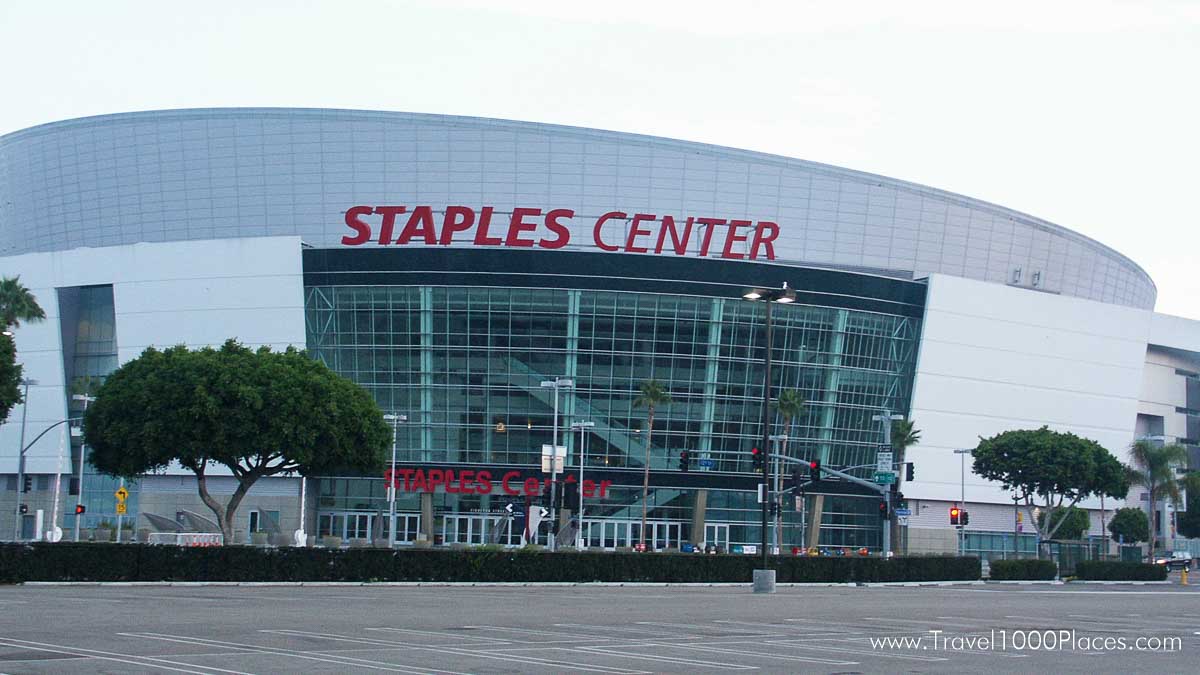
Downtown: Staples Center
One of Downtown’s stars is the highly publicized Staples Center, which is located adjacent to one of the largest facilities for convention, meetings and tradeshows on the West Coast:
The Los Angeles Convention Center.
As the home of the Los Angeles Kings hockey team and the Los Angeles Lakers and Clippers and Sparks basketball teams, this $300 million state-of-the-art arena also hosts some of the world’s largest entertainment and political events, including the Grammy Awards and the high profile Democratic National Convention.
Address
1111 S. Figueroa St. Los Angeles, CA 90015
Downtown: Chinatown
Extends from the 700 to the 1000 block of North Broadway and is bordered by Ord, Alameda, Bernard, and Yale Streets.
Chinatown is the cultural center for more than 200,000 Chinese-Americans.
It feels like China with building roof lines that are exaggerated, curved and heavily ornamented.
Both food and gifts are prevalent; live chickens, ducks, and fish, chinaware, Chinese paintings, books, acupuncture and medicinal herbs fill the shop windows. Chinese New Year is celebrated with parades, beauty pageants and food in February or March.
Downtown: Little Tokyo
Bounded by First and Third Streets from Main to Alameda Streets, southeast of the Civic Center Little Tokyo is the heart of the Japanese-American community.
It was settled more than 100 years ago and besides gift shops and restaurants it is now home to the Japanese American Museum, the Japanese-American Cultural Center, and a branch of the LA public library which specializes in books about the Japanese-American experience and books in Japanese.
Nisei Week is held annually in August with a parade, traditional dancing, festival food and demonstrations of flower arranging, sumi brush painting, the traditional tea ceremony and other Japanese arts.
Downtown: Pershing Square
In the heart of the City of Los Angeles lies one of the oldest of the most beautiful parks, Pershing Square.
Enjoy the unique architecture, art, and landscape from the creative work of world-renowned architect Richardo Legorreta; one of the world’s finest landscape architects Laurie Olin; and noted California artist Barbara McCarren.
Pershing Square is located within the heart of Downtown Los Angeles forming a square between 5th, 6th, Hill and Olive Streets.
Hollywood
Read more: Hollywood Movie Studios
Hollywood: Walk of Fame
West Hollywood L.A., California
Legendary Clubs on Sunset Strip: Whisky A Go Go, Viper Room, Roxy

